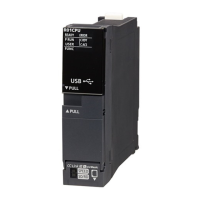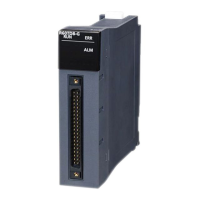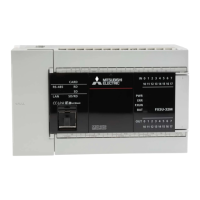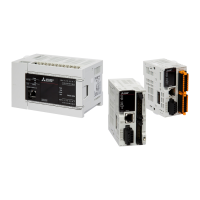1452
15 NETWORK COMMON INSTRUCTIONS
Specifications of character string data specified by link dedicated instructions
Some operands specified in link dedicated instructions are specified in character strings. The following table summarizes the
specifications of character string data specified.
Instruction
symbol
Applicable
operand
Specifications of character string data
READ (s2) ■Specification method
Specify a character string by enclosing it in single quotes (') or double quotes (").
■Specifiable device types
• Word device: D, W, SW, SD, T, C, ST, ZR, R
• Digit-specified bit device: X, Y, M, L, B, F, SB, SM
• Digit-specified word device and bit device index modification: Z, ZZ
■ASCII string specifications
• An ASCII string can consist of a maximum of 32 characters. (Specify NULL as the termination character.)
• ASCII strings are zero-suppressed. (Example: D1 and D001 are handled the same.)
• ASCII strings are case-sensitive.
■Precautions
Digit-specified bit devices can be specified only when the following conditions are all satisfied.
• The device number is a multiple of 16 (10H).
• The number of specified digits is 4 (K4).
An instruction specifying bit devices by digits can be executed only when the target station is RCPU, basic model
QCPU, universal model QCPU, or LCPU. If an instruction uses a digit specification for other types of CPU modules,
an abnormal response is returned from the target station and the instruction is completed with an error. (The network
module does not detect an error during execution of the instruction.)
The target device of an instruction executed in index modification mode is determined by the value of the index
register of the own station.
SREAD (s2)
WRITE (d1)
SWRITE (d1)
SREAD (d3) ■Specification method
Specify a character string by enclosing it in single quotes (') or double quotes (").
■Specifiable device types
• Bit specification of word device: D, W, SW, SD, ZR, R
• Bit device: X, Y, M, L, B, F, SB, SM
• Bit device index modification: Z, ZZ
■ASCII string specifications
• An ASCII string can consist of a maximum of 32 characters. (Specify NULL as the termination character.)
• ASCII strings are zero-suppressed. (Example: D1 and D001 are handled the same.)
• ASCII strings are case-sensitive.
■Precautions
The target device of an instruction executed in index modification mode is determined by the value of the index
register of the own station.
SWRITE (d3)
J(P).ZNRD (s2) ■Specification method
Specify a character string by enclosing it in single quotes (') or double quotes (").
■Specifiable device types
• Word device: T, C, D, W
• Word device index modification: Z, ZZ
■ASCII string specifications
• An ASCII string can consist of a maximum of 32 characters. (Specify NULL as the termination character.)
• ASCII strings are zero-suppressed. (Example: D1 and D001 are handled the same.)
• ASCII strings are case-sensitive.
■Precautions
The target device of an instruction executed in index modification mode is determined by the value of the index
register of the own station.
J(P).ZNWR (d1)

